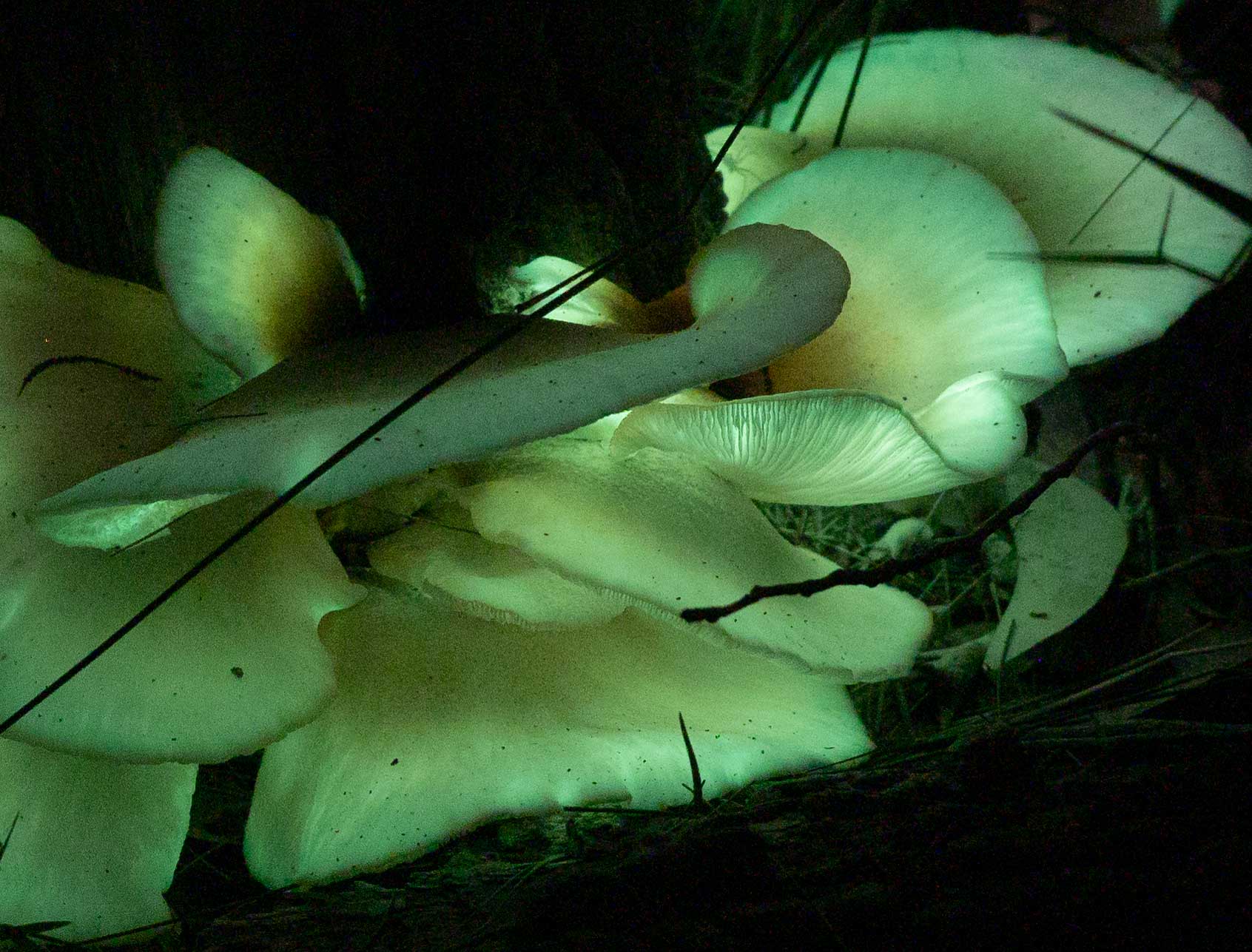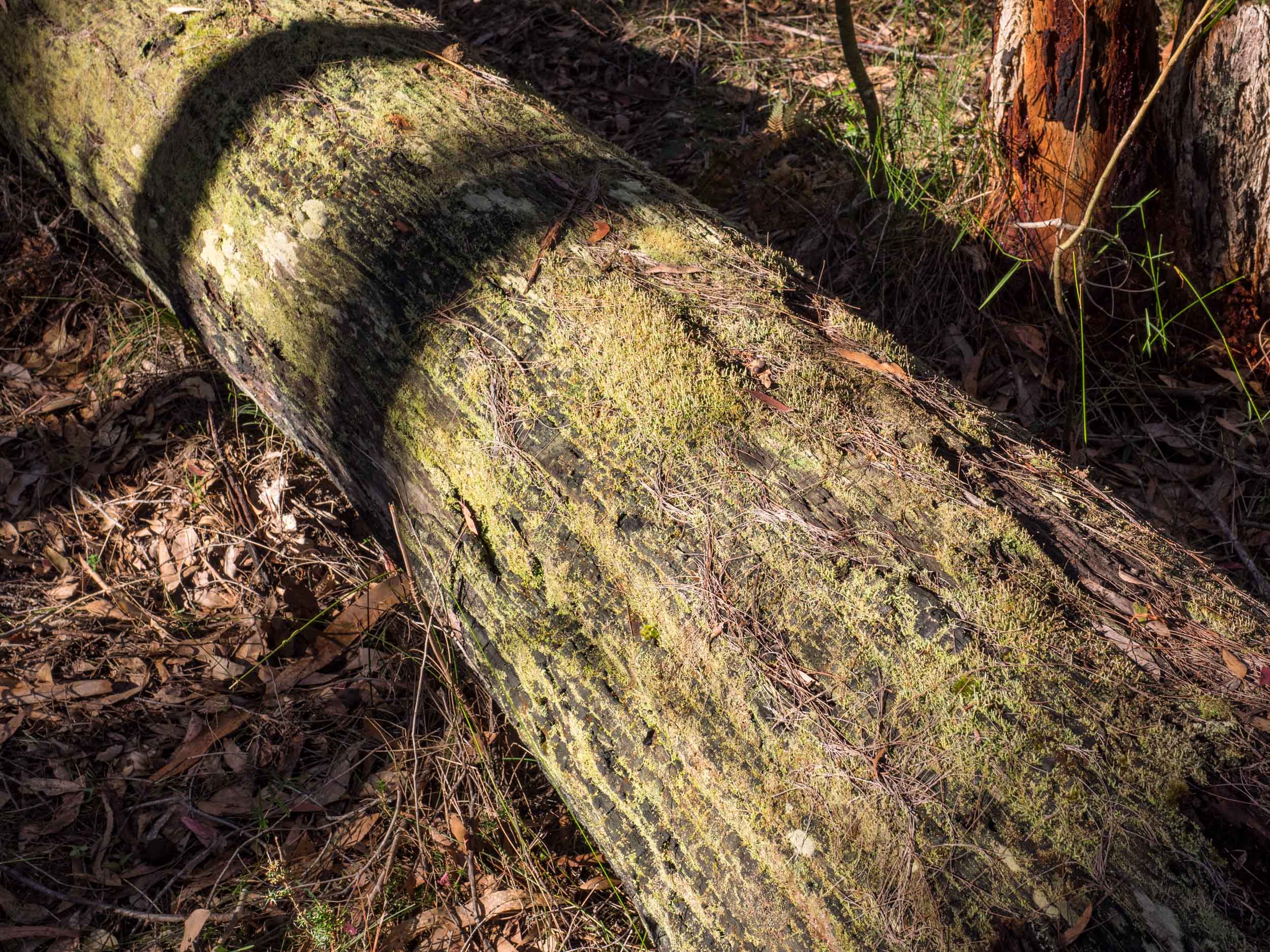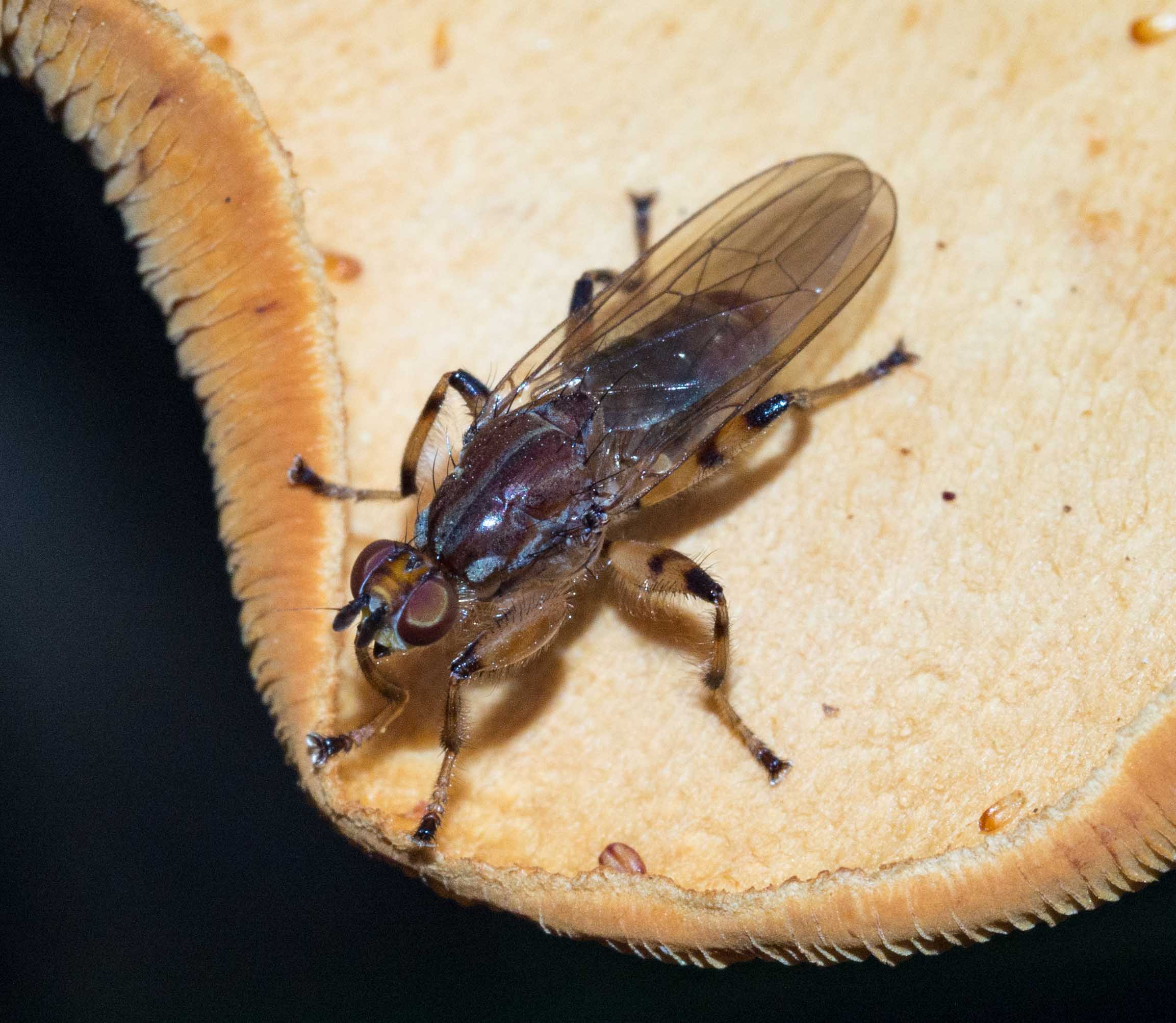Luminescent ghosts

Good rains in late Summer and early Autumn have provided the ideal conditions for a bumper fungi season. We have spent a good deal of time in the last couple of weeks observing and photographing old fungal friends and new on the block.
One of the familiar fungi, which has appeared in large numbers this season, is Omphalotus nidiformis, the Ghost Fungus - an agaric fungus.
These large, fan or funnel-shaped fungi are found on dead or living trees - either on the trunk, fallen logs or at the base of the tree.
Omphalotus is saprotrophic, which means it obtains its nutrients by digesting dead or decaying organic matter - in this case dead wood.
It can also attack the living, heartwood tissue, ultimately killing the tree.
Omphalotus is associated with a variety of plant species. In our forest we have seen it growing on eucalypts and casuarinas.
The Black She-oak, Allocasuarina littoralis seems to be its preferred host.
Ghost Fungus on the trunk of a dead Black She-oak tree (Allocasuarina littoralis)
We have long known about a special feature of this fungus, from which it derives its common name - it is luminescent, emitting a ghostly white light.
But until last night we had never witnessed this strange phenomenon.
Bioluminescence - a primer
Many diverse types of organisms display luminescence. The list includes certain bacteria, dinoflagellates (responsible for ‘blue tides’), jellyfish (from which Green Fluorescent Protein, one of my previous laboratory workhorses, was derived), annelid worms, molluscs, crustaceans, beetles (fireflies) and fish.
In all cases, the bioluminescence is caused by an enzyme, luciferase, which transfers oxygen to a molecule called luciferin, raising it to an excited state. The luciferin molecule quickly drops back to its normal state and in the process releases a particular wavelength of light - which we see as luminescence.
Luciferase and luciferin are generic terms. The actual molecules that serve these functions are very different in different groups of organisms.
Only 71 of the 150,000 or so described species of fungi are bioluminescent - the Ghost Fungus being one of those. Two recent papers (Refs. 1, 2) have shown that all of these luminescent fungi use the same type of luciferin - a molecule called hispidin - and luciferase enzyme.
This study also showed that the peak emission of luminescence from the fungal luciferin occurs at 530nm, which the human visual system sees as the colour cyan/green.
Bioluminescence in our own backyard
A few days ago Kerri discovered a particularly dense, healthy growth of Omphalotus nidiformis on the dead trunk of an Allocasuarina tree.
This image shows the cluster of fungi at the base of that tree.
The best conditions for observing and photographing bioluminescence is when there is little or no ambient light. The moon was rising late at this time so the conditions were perfect for a viewing session - apart from the ambient temperature, which was a chilly 4-5°C!
The Ghost Fungus did not disappoint. Once we turned off our head torches and our eyes adapted to the darkness, the luminescence of the fungi became obvious. It appeared as a pale white glow against the complete black of the tree trunk - quite ghostly!
We stood there in the pitch black and almost total stillness of the forest - interrupted only by the calls of Yellow-bellied Gliders and Powerful Owls - and soaked up this special sensory experience.
I was keen to record the bioluminescence photographically. So I put my camera (Olympus OM-D EM-1) on a tripod, focussed on the cluster of fungi shown in the image above and began a long time exposure.
The results were pretty impressive! A beautiful green image appeared gradually on my camera monitor. The light emanated from within the tissues of the fungus itself. All around was dark.
ISO 800, f/2.8, 216 seconds
As I was taking a second exposure, our niece Luka was doing a time exposure on another fungus. The light from the LCD monitor on her camera cast a pale glow which gave a pinkish hue to the edges of some of the fungi.
And here are images of a fungus viewed from below…
The colour of the luminescence reproduced by the camera is quite different to that seen with the naked eye - green vs. pale white. The true colour, as shown in the study in Ref. 2, is actually cyan/green - as recorded by the camera.
A visual neuroscientist friend reminded me that weak bioluminescence is only visible to ultrasensitive rod photoreceptors, which do not discriminate colours. These photoreceptors are absent from the very centre of the retina. (Thanks David!). Indeed, the fungal luminescence is brightest when looking “out the corner of the eye”. Try this trick when looking for faint stars in the night sky.
What does luminescence do for the Ghost Fungus?
One would reasonably expect that this special property of the Ghost Fungus serves some special purpose. Presumably it takes a deal of metabolic energy to manufacture luciferin and its enzyme luciferase, so there must be some pay-off for the fungus.
It has been shown experimentally that a different species of fungus, Neonothopanus garderni, a basidiomycete from Brazil, uses bioluminescence to attract a range of insects that could help to disperse its spores through the forest (Ref. 3). Luminescence in this species is entrained to a circadian rhythm, which switches on the light only at night.
Does bioluminescence play the same role in the Ghost Fungus? A recent study carried out on Kangaroo Island by a group from Adelaide University (Ref. 4) suggests not.
These researchers found that there is no increase in abundance of insects around luminescent Omphalotus compared to nearby sites without any fungi. Furthermore Omphalotus bioluminescence is always on, rather being regulated by a circadian clock that switches it off during the day.
They suggest that bioluminescence in this fungus is an incidental by-product of some other aspect of its metabolism - perhaps a detoxification reaction.
But in any event, it makes for an excellent show!
References
Oliveira, A.G. et al. (2012) Evidence that a single bioluminescent system is shared by all known bioluminescent fungal lineages. Photochemisty and Photobiology Science 11: 848-852.
Kaskova, Z.M. et al. (2017) Mechanism and color modulation of fungal bioluminescence. Science Advances 3: e1602847. (DOI: 10.1126/sciadv.1602847)
Oliveira, A.G. et al. (2015) Circadian control sheds light on fungal bioluminescence. Current Biology 25: 964-968
Weinstein et al. (2016) Bioluminescence in the ghost fungus Omphalotus nidiformis does not attract potential spore dispersing insects. International Mycological Association Fungus 7: 229-234. (doi: 10.5598/imafungus.2016.07.02.01)











